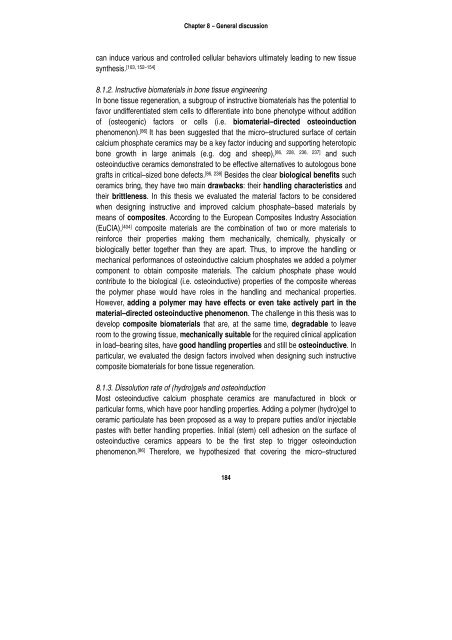Barbieri Thesis - BioMedical Materials program (BMM)
Barbieri Thesis - BioMedical Materials program (BMM)
Barbieri Thesis - BioMedical Materials program (BMM)
You also want an ePaper? Increase the reach of your titles
YUMPU automatically turns print PDFs into web optimized ePapers that Google loves.
Chapter 8 – General discussion<br />
can induce various and controlled cellular behaviors ultimately leading to new tissue<br />
synthesis. [103, 152–154]<br />
8.1.2. Instructive biomaterials in bone tissue engineering<br />
In bone tissue regeneration, a subgroup of instructive biomaterials has the potential to<br />
favor undifferentiated stem cells to differentiate into bone phenotype without addition<br />
of (osteogenic) factors or cells (i.e. biomaterial–directed osteoinduction<br />
phenomenon). [86] It has been suggested that the micro–structured surface of certain<br />
calcium phosphate ceramics may be a key factor inducing and supporting heterotopic<br />
bone growth in large animals (e.g. dog and sheep), [86, 228, 236, 237] and such<br />
osteoinductive ceramics demonstrated to be effective alternatives to autologous bone<br />
grafts in critical–sized bone defects. [86, 238] Besides the clear biological benefits such<br />
ceramics bring, they have two main drawbacks: their handling characteristics and<br />
their brittleness. In this thesis we evaluated the material factors to be considered<br />
when designing instructive and improved calcium phosphate–based materials by<br />
means of composites. According to the European Composites Industry Association<br />
(EuCIA), [404] composite materials are the combination of two or more materials to<br />
reinforce their properties making them mechanically, chemically, physically or<br />
biologically better together than they are apart. Thus, to improve the handling or<br />
mechanical performances of osteoinductive calcium phosphates we added a polymer<br />
component to obtain composite materials. The calcium phosphate phase would<br />
contribute to the biological (i.e. osteoinductive) properties of the composite whereas<br />
the polymer phase would have roles in the handling and mechanical properties.<br />
However, adding a polymer may have effects or even take actively part in the<br />
material–directed osteoinductive phenomenon. The challenge in this thesis was to<br />
develop composite biomaterials that are, at the same time, degradable to leave<br />
room to the growing tissue, mechanically suitable for the required clinical application<br />
in load–bearing sites, have good handling properties and still be osteoinductive. In<br />
particular, we evaluated the design factors involved when designing such instructive<br />
composite biomaterials for bone tissue regeneration.<br />
8.1.3. Dissolution rate of (hydro)gels and osteoinduction<br />
Most osteoinductive calcium phosphate ceramics are manufactured in block or<br />
particular forms, which have poor handling properties. Adding a polymer (hydro)gel to<br />
ceramic particulate has been proposed as a way to prepare putties and/or injectable<br />
pastes with better handling properties. Initial (stem) cell adhesion on the surface of<br />
osteoinductive ceramics appears to be the first step to trigger osteoinduction<br />
phenomenon. [86] Therefore, we hypothesized that covering the micro–structured<br />
184





